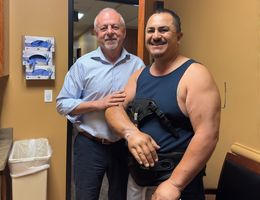
Orthopaedic surgeon, Rebecca Rajfer, MD, gives tips on how to maintain strong bones and healthy joints
Maintaining strong bones and healthy joints is essential for living an active and fulfilling life. As we age, our bones naturally lose density, and our joints can become stiff or prone to injury. When bones begin to deteriorate, it can lead to osteoporosis, a condition where bones become too fragile and more prone to fractures.
However, Rebecca Rajfer, MD, an orthopaedic surgeon at Loma Linda University Health, says that with the right habits, it’s possible to build and preserve bone strength and joint flexibility well into the later years.
"In your youth, bone building is more efficient, but as we grow older, bone breakdown becomes more noticeable,” Rajfer says. "Many people aim to achieve their best health, which is why it's crucial to strengthen your 'bone bank' and maintain joint health as you age.”
Although aging bones and joints are a natural part of life, Dr. Rajfer shares six ways to keep them healthy and strong.
1. Incorporate weight-bearing exercise
One of the most important things for building strong bones and maintaining healthy joints is engaging in weight-bearing exercises –– walking, jogging, swimming, tennis, pickleball, golfing, jumping rope, squats, lunges, and more. Weight-bearing exercises are effective because bones contain sensors that react to pressure by building more bone tissue and strengthening themselves.
By the age of 30, a person typically reaches their peak bone mass, so it’s crucial to engage in exercises that build up this bone density before that time. Afterward, it’s equally important to continue exercising to preserve what you’ve built.
If you're just starting to build bone mass, you don't need specialized equipment, just your own body weight. And, don't underestimate the powerful impact that walking can have on your body.
2. Maintain a healthy diet
What you eat plays a significant role in bone and joint health. Rajfer highlights the importance of eating calcium-rich foods, such as dairy products, leafy greens, tofu, almonds, broccoli, tofu, and canned salmon with bones.
Additionally, consuming Vitamin D is important to help absorb calcium into the body. While the best way to get vitamin D into the body is through direct absorption from a few minutes in the sunlight, there are also various foods containing vitamin D, including fortified cereals, orange juice, milk, mushrooms, eggs, and oily fish like salmon and tuna.
3. Use supplements when necessary
While a healthy diet rich in calcium and vitamin D supports bone health, some individuals may need to supplement their intake, especially if they are at higher risk for bone issues due to factors like age, gender, or race. Additionally, inadequate dietary intake and limited sunlight exposure might be other reasons someone needs to use supplements.
Rajfer also points out that as individuals age, particularly post-menopausal women, the risk of bone density loss increases, necessitating higher calcium and vitamin D levels to maintain bone health. Certain medical conditions and medications can also interfere with absorption, further increasing the need for supplementation. Be sure to talk to your doctor before starting any supplement or new medication.
4. Avoid smoking and alcohol
Smoking and alcohol consumption can weaken bones by reducing bone density and increasing the risk of fractures. Rajfer stresses that avoiding tobacco products, including vapes containing nicotine, is essential for maintaining strong bones.
Similarly, alcohol intake damages bone health. Avoiding alcohol not only protects your bones but also supports overall well-being.
5. Practice fall prevention
As we age, the risk of falls and fractures increases. Rajfer advises older adults to take precautions to avoid falls, such as wearing appropriate footwear, ensuring the home is free of tripping hazards like loose rugs, and even using mobility aids like a cane when necessary.
A single fall can result in serious injuries, such as a broken hip. As people age, bones become more brittle and joints more vulnerable to injury, making it harder to recover from a fall. By practicing fall prevention, individuals can reduce their risk of injury and protect the long-term health of their bones and joints. And if a fall were to happen, Rajfer emphasizes that everyone should have a mode of being able to call for help.
6. See Your Doctor Regularly
Regular medical checkups play an important role in bone and joint health. A bone density scan, or DEXA scan, can detect early signs of osteoporosis, and a doctor can assess your bone health and recommend medications or lifestyle changes if necessary. Staying proactive about your health with regular checkups is crucial to catch issues before they become serious.
By following these six tips, you can build and maintain strong bones and joints, keeping yourself healthy and mobile for years to come. To talk to a doctor about your bone health, call 909-558-2808 or visit our website here.


